MY LIFE AND MY ART
Akvilia Zavisaite (Akvilė Zavišaitė)
(Submitted as part of the requirements for Post-Graduate Degree in Visual Arts at the Newcastle College of Advanced Education in 1987)
INTRODUCTION
This dissertation presents an analysis of my Art in relationship to my life. The reason why this research paper is heavily autobiographical is because a most unusual event occurred in my life when I was twenty years old – I changed not only the country of my birth, Lithuania, but also the continent on which I lived. I experienced severe culture shock adapting to new surroundings and people and I believe this has strongly influenced my self, my lifestyle and my Art.
I am now very happy living in Australia and I consider it my home. Of course, I never forget my country of birth – I will always love my little ancient city, Vilnius, where I was born and where many of my family members still live and work. At present Lithuania is ruled by communist-socialist regime of Russia which I found restricted myself and my lifestyle, a matter of great importance to me. Now in Australia, I can call myself a free person in a free country, a statement which is music to my ears.
I have always enjoyed Surrealist Art and admired Impressionism. I saw Salvador Dali’s work when I was very young and, although it was beyond my understanding, it impressed me so much that since then he has remained my favourite artist of all.
I believe that one can read biographies of the Artist and then understand the person’s art better. It was enough to read van Gogh’s, Toulouse-Lautrec’s and Gauguin’s life stories for me to apprehend their works more readily. Though I have not studied their Art formally, they have become favourites with me as well.
I start my research paper with an analysis of my latest work in Post Graduate Art Course at Newcastle’s College of Advanced Education. There follows a description of my early life in Lithuania, a comparison of Colleges in [two] different countries, and then, as my life moves on, a discussion of the events which have influenced my Art in Australia. I analyse the relationship of my recent drawings to my earlier life in Lithuania. I also describe my working life in Australia and the effect which I believe it has had on my Art. Then follows a short description of my experience in America, and the achievement in my Art in the last twelve months. Illustrations of my work in Art are placed along with the text.
THE DRAWING OF “CENTAUR” – ANALYSIS
This is the largest drawing I have yet done (250 cm x 120 cm) and the task I set myself was to use only pastels – no paints at all – and to use horizontal streaking technique for shading some aspects of the picture contrasting with “rubbing” in other aspects in order to present different textures within the work. The drawing is done on canvas which I washed with black paint first giving me a dark background on which to draw. Pastels “bounce”, or stand out with more effect on the dark surface than on a white one, and the dark surface serves to highlight the forms and shapes.

Drobė, pastelė / Pastels on canvas 1987, 248 cm x 124.4 cm
(Ref. Study No. 1)
This drawing is entitled “Centaur” (Ref. Study No. 1) and depicts a woman so dynamic and strong yet graceful that she reminds me of a beautiful horse. The blue lounge chair is vibrating in the dark and is complementary to the colour of the body, thus emphasising the powerful figure. The colours from top to the very bottom are changing gradually: from warm pink to purples and violets and blues and the change continues on into dark green tones.
The chair behind repeats the flow of the body opening out from the centre: the curves outlines of the chair and the gathered curtains together with a similar gradation of colours behind the figure all lend emphasis to the curvy lines of the woman’s body. The long flowing hair becomes the energy released from the tensed and stretching body providing visually a juxtaposition of straight and soft with tense and curvy.
I chose to draw this figure because I wanted to depict gracefulness and I like this particular pose for an expression of gracefulness I also wanted to gain more experience in pastel technique achieving something that really pleased my eye. The final drawing also would involve me in numerous smaller studies experimenting with colour before I would be ready to commit an actual drawing to the canvas.
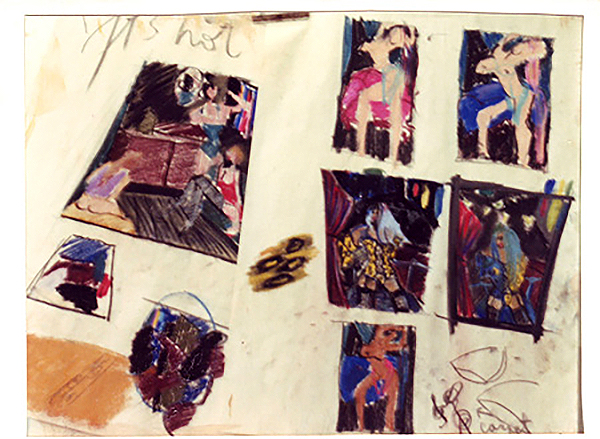
2. LITHUANIA
(a) Early Life
In 1962, I was born Akvilia Zavisaite (Akvilė Zavišaitė) in Lithuanian capital city, Vilnius, a beautiful and ancient place. As a little child, I spent a great time on my own since my parents were busy working elsewhere. Often I’ll be at home alone and my favourite pastime was to draw. In fact, I was drawing since I was three years old. I would sit for hours, sing little songs and endlessly draw animals. The most popular creatures to depict were dogs and horses. I was obsessed with them. I would stroke and talk to, even bring home any dog I met in the street. I took every opportunity to go to the fields where there were horses to hug and ride one. I accumulated stacks of pictures of all these animals. The drawings were very appreciated by my parents, friends and children at my school. Everyone wanted to have one of my quick, one-line drawings of an animal.
Later on in my life, when I entered Newcastle College, I tried to draw and paint my favourite horses and dogs again. However, I was strongly advised to change my subject-matter. It was thought that my art was too clichéd and conventional. After I began drawing figures of humans, I understood that the problem was not in the animals but in the way the object was depicted. I believe that one can make any kind of image strong and powerful, depending on the composition, the colours and technique used.
Soon my parents were divorced and then lived in different cities. I loved spending half a year in one part of Lithuania and the other half on a “paradise” resort island, surrounded by the sea and nearby lake, with huge pines and sand dunes.
My father was a handsome man and flirted with the prettiest ladies in town. He always encouraged me to get involved in sports and even more so in drawing – he was a brilliant architect. I would go with my pad and watercolours and sit on the shore, dip my brushes into the lake and paint. I do not remember producing great “masterpieces” of the landscape – I was more interested in sneaking into the bars with him and watching all he people drinking and laughing with each other and with the charming barmaids. I would feel so proud of my very popular dad.
Later on, in my first year at Newcastle College, I made a huge painting of two people drinking in a bar. Presented here is a detail of this painting

Acrylic 190cm x190cm
(Ref. study No.3)
which depicts a sorrowful couple drowning their feelings of sadness in a bottle of vodka.
A task for First Year students was to paint with a 5 cm wide brush using white and black paint. This was the immediate image which came to my mind – two sad drunkards of my country. The picture was purchased shortly after I completed it – my first sold work!
As I grew up, I came to know my stepsister Rasa, who was an art critic and a very happy person who associated with those of a different perhaps more sophisticated circle than I and my friends. In Lithuania, there are many gypsies who wander the streets in long flowing attire. They usually have long black hair and are adorned with gold jewellery. Most of the gypsies would carry cards for the purpose of reading people’s fortunes.
Rasa and I admired the gypsies’ freedom of expression and sometimes we ourselves would become gypsies and drink red wine, dance wildly on tables to guitar music entertaining a whistling clapping and appreciative audience. I strongly believe that this had some bearings on my dream to become a professional dancer.
(b) Studies
Time passed, I had finished school and had to consider my future. I still wanted to be a dancer and/or barmaid. It was to me so romantic a career-path but I was soon talked out of “becoming a Barmaid/Dancer”, and encouraged instead studying Art.
Oh dear! No matter that I had excellent marks in drawing and a quite good School Certificate; I could not achieve entry to the Art Institute in Lithuania. College entry [there] is not as simple as in Australia. One has to pass entry exams in Literature and Scientific Communism as well as in Painting and Drawing tasks. I was rejected at once by the Institute authorities because I was not a member of the Young Communist Union [Komsomol]. One must have that important “stamp” to study Art. I had to quickly find and alternative study course and so I entered Teachers’ College [Vilnius Pedagogical Institute] to study English since this was the easiest to enter.
It was hard work six days a week, from 9 a.m. to 6 p.m. and then homework. The work load is so heavy because, besides five other language subjects, one has to study subjects like History of Communist Party, Military and Medical subjects – I have a Certificate of Nurse of War!
(c) Comparison of Colleges
I came to really appreciate the College in Newcastle, and indeed the whole education system in Australia. My experience is that in the U.S.S.R. people are generally not valued as free human beings. If one holds some position in the Government with its accompanying driving a black car, wearing solemn suits and sporting “big gut”, then of course, everybody will bow their heads to one, but people holding positions other than in the Government no matter whether as a writer, a teacher, a doctor or a manual worker will find themselves being treated most rudely by shop assistants, or being sworn at by cab driver or cleaners. There is also abuse in School departments. I well remember a Russian Literature teacher at High School shouting and calling us children of alcoholics, abusing our parents, calling us dumb idiots, sots, cripples and so on. It was not permitted to say anything back, no matter how insulted we felt. There was not much more respect shown in the Teacher’s College. The authorities in the Tertiary Education Departments treat students as dolts i.e. with great disrespect. They may shut the door in front of your nose, or shout “Out! I am busy” even if you knock politely, before entering their office. I shan’t forget a Sociology lecturer, who failed my work five times. Each time she agreed to an appointment with me to discuss my failure. However, she would have me wait in the corridor for up to two hours whilst she chatted and sipped coffee with her colleagues, taking no notice either of me or of my lost time. Such treatment of students is accepted as normal in the Soviet Union. It is no wonder many people I the U.S.S.R. are angry and depressed. Much unnecessary irritation and distress is created for those who live in a totalitarian or authoritarian system.
Bribery and corruption are also acceptable. On one occasion, our group of students, five girls, was going to the Medicine exam and we gave our teacher a bottle of brandy. We all benefited. He went to another room while we were sitting in the classroom preparing the answers for the exam, and we would hear him un-wrapping that brown paper parcel and sipping the alcoholic contents.
In Australia, there appears to be no rudeness and anger between the lecturers and the students. The first thing I noticed following my arrival in this country was the general politeness, smiles and friendliness. It was almost a shock to me that students call the teachers by their first names. I was very surprised that lecturers and students voices are of the same tone. It seemed like everybody was on the same level.
I came to the conclusion that this is a very fair country at least as far as students and therefore human rights are concerned. At College here, a teacher may fail your work but he or she does not abuse you for it. I found a very friendly and warm atmosphere in the Newcastle College; my lecturers and tutors have always been helpful during those four years I have studied there.
It is said that education is free in the U.S.S.R but this is not quite true. Officially there are no fees applicable in tertiary education but once you decide to study you have to be prepared to pay bribes unless you know someone of influence. To enter some universities the bribe has to be big! To pass the entrance exam for Medical School, the average bribe would be 1000 roubles to a teacher [examiner]. You have to be careful not to give too small an amount of money as you can say good bye to both money and university. Everyone keeps quiet about it because according to the law both the taker and the giver may go to goal if discovered. So much depends on whom you know and how much you know.
However, people of Lithuanian nationality are very hard-working people and very hospitable and friendly. As long as it is not in the public eye, that is at home, with friends and acquaintances, a Lithuanian man would ask you to his place, cook you a meal if you are hungry, give you a drink if you are thirsty, sing and dance with you to cheer you up if needed. In contrast to this I see that people in capitalist countries are somewhat colder towards each other, a bit more preoccupied with their own concerns of income and maybe a bit tense about their careers and personal success – there is big competition in the business world, the essence of capitalism.
I am sure that finding myself in a “free” society and studying at a College where the atmosphere is relaxed and encouraging has had a very positive influence on my progress and development as an artist.
3. OLD ACTRESS’ HOUSE
To return briefly to student life in Lithuania, although I had quite a rewarding teaching practice [period], I found a great lack of visual aids to brighten up the English lessons for my pupils. So I would make them myself e.g. posters of fairy-tales, colourful drawings on the blackboard and my pupils loved it. They used to line up during their brakes with sheets of paper. I had to draw quick sketches of the chosen subjects usually animals. The three months of school practice passed quickly and successfully and the teachers very much wanted me to on teaching there. I thought of becoming an Art Teacher.
About this time my mother went to Australia, married an Australian and stayed there. I moved to a big old-fashioned house, very noble and grand, where a charming retired actress [Elena Petrauskiene] lived. She was 83 years old, petite with curly grey hair, always wearing long silky gowns and lots of earrings, rings, bracelets and necklaces. Her old “girlfriends”, also former actresses, used to visit her often: they would sip red wine, play cards, and laugh gaily. The old lady had three grandsons in their early teens, high-spirited and difficult to control, and two dogs. It was my job of sorts to look after this family. Of course. I would bring my friends to the house as well, so we had a very jolly group of people of different ages.
I admired and loved this old lady and I think this was [one] of the greatest times in my life. She has had a long lasting effect on me. Later on, when I was living in Newcastle and studying Art, towards the end of Third Year, I made a picture called “Queen of Clubs” which depicted three ladies playing cards and sipping red wine.

Popierius, pieštukas, pastelė / Pencil, pastels on paper 1985, 120 cm x 80 cm
(Ref. Study No. 4)
It was actually my first big pencil drawing [120×80 cm] and involved much research. I wanted figures to look graceful, well-shaped with certain expressions on their faces so I spent lots of time sketching different parts of the body, using anatomy books. All the drawing is done on a rough surface paper using a simple pencil and some black oil-crayon. The picture is slightly distorted but the prolonged, curled up lines and the exaggerated shapes emphasise the characters and it gave me pleasure to play with the expressions. This was my first more or less stylised work.
4. AUSTRALIA
It was three years before I could join my mother in [Sydney] Australia. Arriving in this beautiful, warm and friendly country was the biggest event of my life. It was a new and different world for me. I lived with my mother for a few months and then moved to Darlinghurst, an inner city suburb of Sydney, not far from city centre. I was invited to share a house with Lithuanian lady who was an Art Teacher in a school. The punks and street people, tramps and all sorts of strangers everywhere amazed me. Such people were never heard or seen before by me. I soon realised there were no gypsies but a big variety of women. One could make judgements about a type or style of person by their looks. There was such a wide range of different clothing, allowing everyone to be stylish in their own way. I could choose which type of person I would like to be seen as.
In U.S.S.R. people adopt a more or less familiar look to each other. If you are wearing something different than others, or hold or carry yourself slightly differently from the mass, everybody will turn their heads at you in the street with a shocked look on their faces and you may receive loud comments about your clothing or behaviour. Here was a place where I could choose to be quite individual and also be acceptable.
I found some work whilst living in Darlinghurst – I worked as a waitress at a theatre restaurant, as a barmaid at some pubs, and as a breakfast cook in a motel. I usually lasted working only a few weeks in each job because of my language barrier.
Also whilst in Darlinghurst, I attended some evening Drawing Classes at East Sydney Technical College. There were two classes each week and there I had my first opportunity to draw from a life model.
At the end of this year, I applied for entry to various Colleges in the New South Wales to undertake an Art course. I was invited to an interview at Newcastle’s C.A.E. again an unknown, unheard of place to me. On showing my portfolio (drawings I produced whilst living in Sydney) and passing some tests, I was accepted as a student by this College. Great, at last I was going to formally study Art!
5. NEWCASTLE COLLEGE
This College offered a wide variety of different branches of Art, plenty of scope for experimenting and one could choose the subjects one wanted to study. The facilities at the College were excellent with ready supplies of canvasses, paper including coloured variety, pencils, charcoals, some brushes and paints. Day classes were available. In U.S.S.R. students can not get decent paint-brushes even from the shops. There are no such supplies for students at all. One has to make them or get them from somewhere. At this College, workshop assistants were always ready to help with problems, give advice at any time.
There was a big variety of Drawing classes and I attended most of them. Each lecturer had his or her own way of teaching, individual style and tasks. There were Anatomy Drawing, Three-Dimensional Drawing, Illustration, Perspective drawing and Life drawing as well as some others. Best of all I liked drawing with charcoal and experimental drawing using distorting mirrors. The latter especially absorbed me and, since at this time I wanted to do only distort images. I did a few self-portraits looking at my reflection in a glass, in an iron, spoons and so on.

Pieštukas ir akvarelė ant popieriaus / Pencil and watercolour on paper 80cm x 45cm
(Ref. Study No. 5)
This portrait was produced using water colours and pencil, employing a distorting mirror. A second portrait

Popierius, pastelė / Pastels on paper 1987, 35 cm x 20 cm
(ref. Study No. 6)
was done using an electric iron. I loved the twisted image of the kitchen in the background, and the whole composition of shapes seen in the iron. Sometime in the future I would like to make a big “iron” drawing on canvas, possibly having a frame in the shape of the iron.
Also displayed in this section are some charcoal drawings “Ladies on the Beach”,

Anglis ant drobėes / Charcoal on canvas 160cm x 70cm
(ref. Study No. 7)
using black acrylic washes on the canvas first, and then using charcoal and white crayons on top.
During second year I majored in Ceramics. It was a most enjoyable time for me. Every kind of class was available, wheels for throwing the clay into shapes, various glazes and paints. The teachers were very tolerant, allowing you too produce any kind of work you wanted. It was very free. If you wanted to make pots, here was a wheel for you, and the tools, and lots of encouragement and tuition. If you wanted to make moulds, here were the shapes and forms for your moulds. If you want to play with the clay, here, mould anything you like. These teachers also help you to choose the right glazes and then would fire your completed work. Also there were ceramic sheds in an annexe in Union Street in the city where students could stay working until 8 or 9 p.m.
I was obsessed, at this time, with distorted cups and saucers, and later on I loved making ashtrays most of which I gave to my friends. Making ashtrays was a favourite hobby and provided variety of light-hearted kind in my subject-matter.
Finally, in Third year, I decided to major in Drawing. It was a big decision made with some difficulty. However, practising with clay and especially sculpturing the clay helped me to develop my drawing skills, to produce more three-dimensionality in my drawn images.
6. THE BELLEVUE HOTEL
By this time, the third year of my course, I was in financial difficulties and had to find paid employment to supplement my student allowance to allow me to survive with some degree of comfort. Here was an opportunity to make another dream come true! I discovered a sailors’ tavern in the midst of Newcastle employing dancing girls. Well, they were not glamorous gypsies but it was a performing show. There were crowds, music, noise, laughter, drinking, smoking, a colourful stage show with outrageous girls. I applied for and gained a job and decided to work there for a couple of years. It was convenient because during the days I could study, late in the afternoon I could relax and enjoy myself and continue on to work as a dancer. I loved it – all these shiny, silky, little costumes and wigs, wild dancing, long hours sitting at the bar and sipping vodkas during the breaks, all these loud people and girls kicking their legs and swinging their skirts. All reminded me of Toulouse-Lautrec’s lifestyle. I was very fond of his works, but I also thought of him as clever and outrageous. You see, maybe it was France, and the dancing girls were laundresses of the Moulin Rouge of the 19th century.
I created the world that I wanted to live in and it seems it has always been like that for me. Therefore, I am a very happy person!
During breaks in my dancing, I would often sketch people in the beer-garden. They were simple people and shy in a way, but they all want to be drawn. “John, it’s your turn!” or “Go on, come on, she wants to draw you”, they would shout and there my subject would be coming to the table often protesting that “it should be someone else, not me”. Then he would sit quietly and patiently whilst I drew his portrait. Afterwards his companions would gather around and discuss the portrait, and compare him and the picture and see how much of the detail was similar and with much seriousness After all, this was the lowest pub in town with the biggest brawlers, thieves and drunkards for patrons yet they were most interested in the artwork. I tried to do my sketches as accurately and as realistically as possible and my favourite persons to draw were the twisted, wrinkled or even crippled ones as they have such interesting expressions in their faces and make excellent characters to portray
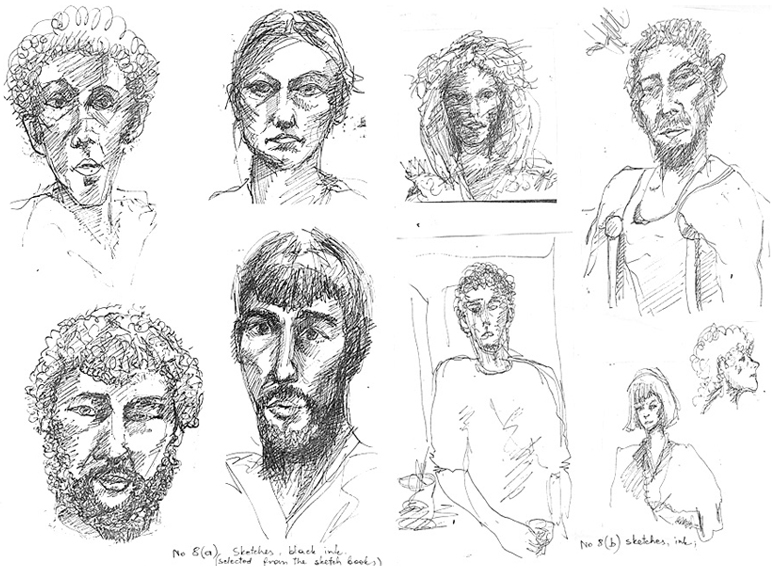
The girls working there were very keen to be drawn too. They would pose this way and that way but I usually had to be very quick to sketch them in the dressing-room, because during the breaks they were eager to run out and meet people.
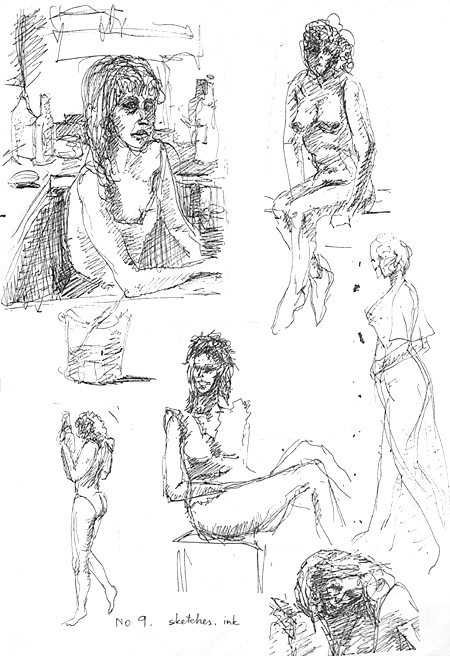
7. STUDY OF THE “RED DRESS” AND OTHER DRAINGS IN PASTELS
During this time working in the Bellevue, I produced “Red Dress”

Pastelės and drobės / Pastels on canvas 145 cm x 70cm
(ref. Study No. 10).
It was a picture of a girl standing lonely at the bar. It was a distorted figure, in a twisted pose, with exaggerated shoulders, hands, elongated arms, legs and waist. I wanted to draw a distorted figure because the twist creates a certain mood, a feeling. It emphasizes what I want to say in the picture, i.e. long, thin figure gives an impression of loneliness, maybe even of hunger and exhaustion
This was my first picture done with pastels. I glued black material onto the board and the pastel colours stood out almost passionately. I especially love the effect of red on the black background. I was able to blend the colours on the material to achieve the right toning so therefore I tried streaking the body in multiple colours. It was a really difficult task and my first experience in that medium and technique. There were purples and greens, reds and browns, and blues and yellows in the shading. After making just a few strokes, I had to step backwards each time to view the form because I could not see it all when up close – the point was not to hurry. It took me a long time to get the form of the body “working’, but at the end I was happy with the work. Since then using pastels on material or raw canvas has become a favourite technique.
During these times, I did a few pastel drawings at home. Actually I was combining coloured pencils and pastels on paper. I produced a few images from my imagination just to enjoy the shapes and lines, enjoyed shading with the pencils and making some parts decorative. I could not avoid making the red dress hanging on the line entitled “Spring Girl” (ref. Study No. 11).
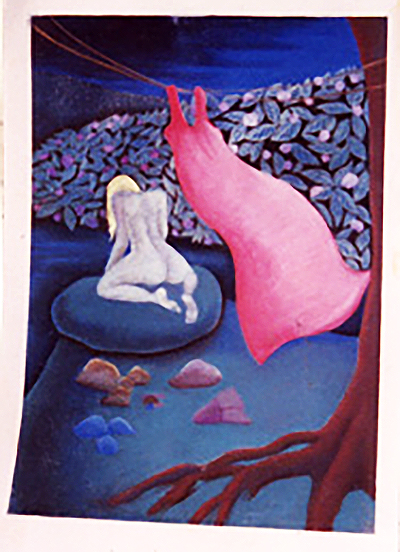
Pastels on paper 100cm x 50cm
(ref. Study No. 10).
Another picture finishes at home, again using pencils and pastels, was of a real model, sketched in a drawing class, and again I was compelled to make a bright red cloth in this picture (ref. Study No. 12).
8. THIRD YEAR ART AT THE COLLEGE
(a) Life in “The Studio”
As the end of Third Year was approaching I was living in a big, beautiful old house alongside the ocean and beach in East Newcastle. I could see the ocean through my bedroom window, could go jogging or swimming on the fresh morning, all marvellous. I was one of five people sharing this house. Three of us were Art students, the others working people. There was a huge lounge room, with two big tables and few easels. Raymond, 32 year old, had been painting for twelve years, and Damien, a student from mu course, was a drawer. Actually the house had a most apt name “The Studio”, and was very popular amongst our friends. It was never empty, mostly full of visitors, even dogs, in the afternoons. It was a very inspiring place to live because there was a mass of ocean surrounding the house that represented at once freedom, space, and openness. Also there was something artistic going on all the time, and the atmosphere was sociable and cooperative – we would share our meals around the table as well as discuss our art any time of the day. We seemed to have a good influence on each other, learning from each other’s mistakes and criticisms.
At this time Damien and I were doing lots of coloured pencil drawings. I found there is nothing more satisfying than to sit at the table with your friend or alone, listening to the music and drawing. I also found drawing with coloured pencils very soothing, calming. Each of us had a different approach to our Art.
Raymond was experiencing with his paints, trying to push himself further. He was producing multicoloured semi-abstract paintings. Damian loved abstract shapes, beautifully twisting and tangling and growing out of each other, making an abstract image; sometimes he would draw surrealistic interiors and always with a Rose Lady included, i.e. a lady with a rose for a face or a head. I think he was preoccupied with Rose ladies and he was very successful in depicting them. I wanted to draw figures, beautifully shape them on coloured paper, doing something personal and private or just being soft and feminine.
(b) Star Signs
While experimenting with my feminine figures, I conceived an idea to depict twelve females, each representing a Star Sign or Zodiac sign, since I was most interested in astrology at that time even preoccupied with it in my spare time. It would be an interesting task for me, because each sign represents some part of the human body on some accounts. So I thought simply to emphasize that particular part according to the sign.
First came a pink lady with a big belly and was called “Cancerian” (ref. Study No. 12) since the sing Cancer is said to rule the belly. Then came the picture I called “Sagittarian” (ref. Study No. 13)
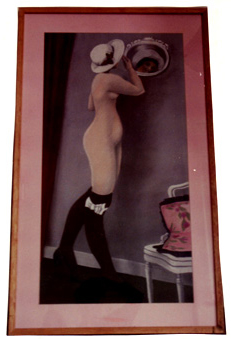
Cancerian
(ref. Study No. 12)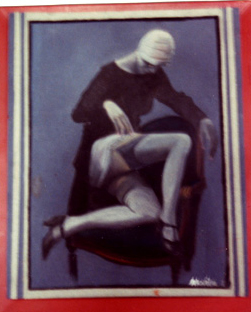
Sagittarian
(ref. Study No. 13)
with a girl showing her legs since Sagittarius is said to rule the tights. I commenced “Leo Lady” but I was somewhat unsuccessful in what I was trying to achieve, I could not get the image the way I wanted it, so I dropped this subject.
The end of Third Year was fast approaching and I thought I would not be well-received at the Review with my little pencil drawings of the Star Signs. It seemed like I should produce something more solid, larger and powerful.
9. ANALYSIS OF “GIRL AND HER BELONGINGS”
I knew I was required to draw from life for this final part of my course. It could be an everyday happening; it could be something about which I felt strongly.
My relationship with my boyfriend had just broken up. I was very distressed, packing my things, sorting them out, yet not knowing where to go. There was a mess both in the room and in my head. After two days of indecision I was sitting on a box and drinking red wine with a friend who was trying to cheer me up, and also trying to talk me into becoming his steady girlfriend. I felt totally confused! While chatting with him, I made some sketches of my surroundings, actually putting myself in among my things.
After all I did not move at that time and had to unpack my things and get myself together. I made the picture “Girl and Her Belongings”.
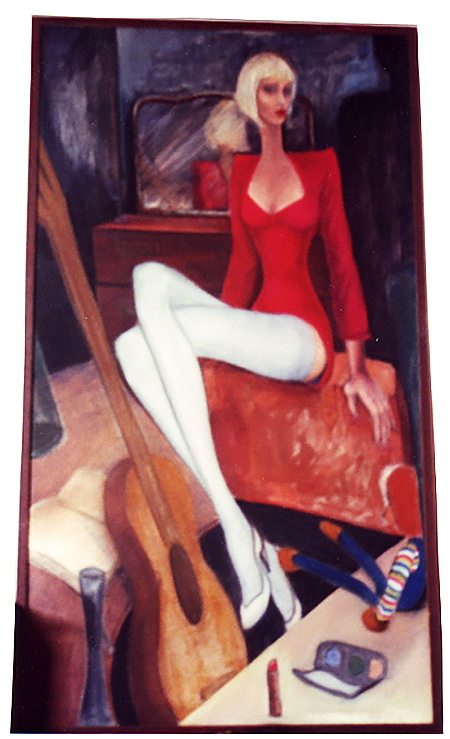
Pastels on canvas 180cm x 90cm
(ref. Study No. 14)
It was only 180 cm x 90 cm in size, but it was the largest drawing I had yet done in pastels on canvas. Acrylic was used for one object (the luggage), while the rest of the picture was exclusively done with pastels. The canvas is raw and unprimed. The objects depicted are ones that are important to me, e.g. my guitar, a book, my toy, make-up, bottle (corner showing), a bong fallen upside down, a man’s black silhouette in the background, and myself sitting “in question”, a confused expression on my face.
I really enjoyed making that picture and there was only one wish in my mind when I completed it – to make and larger, longer drawings with pastels on canvas!
10. FINAL YEAR EXIBITION
The final Exhibition of Third Year students’ work I thought was brilliant. There were all sorts of works exhibited, spread throughout the College buildings. The Ceramics works were strong and impressive with the paintings and drawings not far behind.
We Drawers, eight of us organised an Exhibition at the Speers Point Art Gallery as well and it was a big success. Some viewers recognised me as being the subject of my drawings when meeting me elsewhere later. It was very pleasant to know that the images had impressed them and stayed in their minds for a length of time. However, none of the pictures were sold. Perhaps the prices were too high as some people made inquiries about the works and their prices but did not finally purchased any of them.
11. AMERICA
After graduation from Third Year and gaining my Bachelor of Arts (Visual Arts) degree, I stored my artwork at friends’ places and left for America to visit my mother who had moved there to live and work a year before.
It proved to be the wrong time for me to go there. It was wintry and snowing, and I did not get a chance to make new friends since everybody was hiding indoors from the cold. I stayed in Washington [D.C.] first and was amassed to discover so many galleries and museums. I spent my days in these buildings seeking the original works of the most profound artists. Many of their works I had seen before in books, but, of course, it was a different impact for me to view the originals.
I was most impressed with Hirshhorn Museum and even purchased a number of calendars from its shop.
I visited my girlfriend in Chicago and stayed for a while there. She was not too much a “cultural” person, but we visited plenty of bars and discos, and I gained a fairly wide view of Chicago life. We visited a couple of small contemporary Art Galleries, and once I visited the big National Institute of Art. Here was an enormous variety of different art works, ranging from ancient times to the very modern times as well as Indian, African, European and American art.
Soon I had enough of my nose freezing in Chicago so took a flight to New Orleans. There I heard music that still rings in my ears. It was an absolutely amazing works of jazz and blues played by very skilful black people. As far as Arts is concerned I visited only a few outlets of the local people.
My last short stop was in California, in the city of Los Angeles. I visited a few commercial places like Universal Studios, Hollywood Boulevard and so on. I was quite surprised to see these plastic models of famous people in some museums or show places. It was quite entertaining.
After all this, I was now eager to come back to Australia. There was so much tension and poverty and such a hard life for students in America that I knew with certainty that it was not the place for me. However, America did have some influence on my work. One day I would like to return to the U.S.A. and visit notorious New York. It is said to be a nest for artists, especially immigrant ones. I am told they all feel at home there and have plenty to share, to see, to exhibit, and to challenge. It sounds very attractive and therefore it has become another dream to pursue!
12. ANALYSIS OF “LOST GIRL”
After returning to beautiful, warm Australia and settling down at my friend’s place, I started drawing again at home. I glued some cheap green material to a big board. I made an image of a girl standing alone in a deserted, dark and dreary street and named it “Lost Girl”.

Pastelė, drobė / Pastel on canvas 185cm x 125cm x 90cm
(Ref. Study No. 15)
The picture represents how I saw America.
Besides the huge museums and galleries, homes like castles, big, expensive cars and great wealth apparent, there were also plenty of dark, narrow streets with poor shabby houses where some parts of the building would be abandoned and in other parts people would be sheltering. I stayed with a girlfriend in one of these Mexican-Spanish suburbs in Chicago. The first two floors of her building were “dead” – walls peeling, pipes hanging out like monsters – dark and cold and full of screeching cats.
And here she is, standing alone in this crooked street, nor knowing which way to go. The picture is a metaphor for life for many in U.S.A. Many people I met in the States on my travels told me that one has to be very careful all the time because times are tense and insecure, and almost anyone will take advantage of you if they can. I experienced this myself with people lying about something or just being insincere for a few dollars. I found life there was aggressive and quite sad.
In the process of making this picture it changed its shape. As can be seen, the top of canvas is much wider than the bottom. Whilst in the midst of creating the image, I realised that composition was wrong. I tore off the material from the board and the pastels rose as a big cloud into the air and I was left with a vague image in my hands. Since the streets were twisted and the girl herself has evaporated, I felt free to re-form the shape of the canvas. This last form was most pleasing to my eye.
The girl is standing under the street-light, one shoe off, and the pavement corner so exaggerated as to emphasise the confusion. The loneliness with no other vital soul present. There is the black shadow of the girl and then her glowing body in the red dress symbolising something burning with life. Eager to search, to live to bloom!
13. THE FOURTH YEAR OF STUDIES
(a) Mrs. Westbury’s portrait
A New Year had come and time was passing. I still could not imagine myself doing just any kind of work, especially office-type work. I knew I was only interested in being occupied with Art, and perhaps to continue my part-time employment as a dancer.
I therefore enrolled in the Fourth Year Art ant Newcastle’s College, and was ready to pursue my post-graduate course with eagerness. I think I wanted to “belong” somewhere – I could not stand the idea of being a “nobody”. So I became a student again and now I have to say that this has been the most rewarding, the most free and mature year of all my student days. There are nine of us seeking graduation and each of us has been allocated a part of the College Studio. The lecturers have been helpful when needed and the whole attitude has been even more relaxed than in undergraduate years. I have felt like “a real artist” coming anytime it suited to work and feeling most comfortable doing so.
During this time, I was asked by a friend to paint his mother’s portrait using photographs (his mother has died). After doing a few studies of the face, I worked out the composition and the mood of the picture. The lady is very pale, with a sad smile sitting in dark clothes in the almost black background. In front of her is a coffee table with a very bright bunch of flowers. My task was to juxtapose vitality with mortality.
At first it seemed quite simple but as it was developing I became more and unhappy about the picture. Somehow I could not get it “right”. I spent hours working on this portrait and the more I painted the worse it was getting. The face became crooked, nothing like Mrs. Westbury. I could see a monster staring out at me – I gave up. Although I have not presented here an example of this picture, I mentioned it because it took me two months of work before I realised I was not interested at all in this subject. I knew nothing about the lady. I had never met her before death and I had no feeling for her. Is this why I could not paint the portrait of Mrs. Westbury?
(b) The Triptych
I now return to the subject matter I had chosen for myself using techniques I had developed for myself. I acquired a raw canvas and pastels. The plan was to make a Triptych of the dancing Girls.
The previous picture “Lost Girl” inspired me to produce more images of these dancing girls and also I had many sketches of the ladies I met in the tavern. The idea was make three odd-frame shapes for the drawings which could be viewed together as in one picture or separately. I built up a story to match my “Lost Girl” which had to be the last panel.
The middle panel presents the dancing girls in their dressing-room

Pastels on canvas
185cm x 145cm
(Ref. Study No. 17)
fixing their hair and nails, resting, waiting for the show to start. There are colourful clothes hanging in the right corner, the black girl’s reflection in a mirror, make-up on the cupboard as well as a bottle.
In this picture I used acrylic in some parts (sofa, legs of the girl in the centre) but the largest portion is in pastels.
The first panel depicts a “Stripping Girl”

Pastelės, drobė / Pastels on canvas 185cm x 125cm
(Ref. Study No 18)
I did this drawing using pastels and charcoal except for the curtain on the left which is in acrylic. The stage-lights are shining on the body, so I used lots of different colours e.g. blue, brown, reds, purples, on the body and hair. Navy flags can be seen hanging above the colourful stage and the bar in the background. The body and the stage floor are done by streaking with numerous pastel colours. The lines which form the curtains and ceiling, the bar and the lights, and even the floor are all forming a tapestry. They are crisscrossed and create the energy while the body is smooth and soft yet the yellow lingerie-covered torso becomes the centre of impact where the dynamic lines meet like waves then ripple back.
After I had finished this Tryptych, I realised that I have formulated a certain style. I knew what and how I wanted to draw in the future.
14. THE FUTURE AND MY ART
The end of Third Year Art saw the beginning of my understanding of my own Art: ideas and inspiration had grown incredibly. The post-graduate Fourth Year has seen the development of my own style. I am very happy about this because I spent the previous years just floundering about and trying to draw something that would satisfy my feelings. I wanted to depict something graceful, dynamic and emotional. I tried using inks and oil pastels, watercolours and acrylic yet I could not achieve the effect in colour and lines I was after. I did not know what to grasp at next.
My plan now for the future is to develop and push my pastel technique further. I would like to complete more really large or long pastel drawings, to train myself completely with this particular technique, and subject matter – female figures.
At some stage, I would like to release myself from drawing only female figures unless they develop into something magnificent. I know I am going to draw them for a while, exploring the colours and the shapes until one day I will have had sufficient.
I believe that some kind of animal/human creature is forming in my imagination. I would like to combine my other hobbies like astrology, the mysteries of the psyche, even perhaps palmistry with my Art. These preoccupations are already becoming the subject matter or are at least having as inspirational effect on my Art. At present I live in the world of these things – they are currently my main interest in life.
I consider Australia my home now, and the main task I have set myself after graduation from college is to find my own studio space where I can work and explore my Art. Whether I sell my pictures or not is not of great concern but I would certainly like to earn an income doing some kind of artistic work.
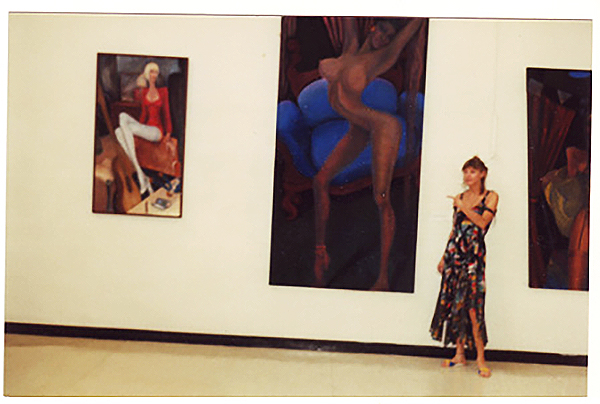
1987 Newcastle